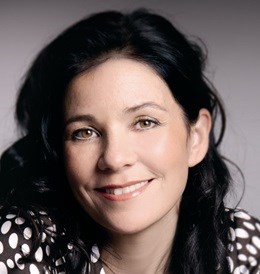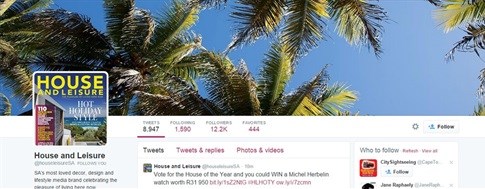AMP shows other publishers how print can embrace digital

Has there ever been a more difficult time for publishers to keep and grow their paying audience than now? Following the recession of 2008, absolutely everyone looked to cut costs. For media consumers, that meant turning to online, particularly if the content was free. Sadly, many traditional print publishers saw this as competition and a threat instead of as a new opportunity to spread their wings.
Raphaely says family-run Associated Media Publishing (AMP), founded in 1983, wasn't immune to these pressures. Luckily, they picked up on the winds of change in the publishing industry many moons ago and took steps to future-proof their stable by taking note of the many online opportunities on offer.
Here, Raphaely shares Associated Media Publishing's strategy. It's a key one in the industry as AMP is rather prolific, publishing Cosmopolitan, House and Leisure, Good Housekeeping (including its Afrikaans counterpart, Goeie Huishouding), Marie Claire and Women on Wheels (WOW)...
We often hear 'print is dead', and we know your local O magazine recently shut down - is it more a case of 'print is no longer just print, but must go digital to survive'?

Raphaely: I believe every brand (not only media brands) will have to successfully implement a digital component to their positioning to survive. In our case we have the benefit of established print products to drive and work alongside our digital properties and, yes, we can't rely on print alone to sustain and future proof our products. Our audience is using multiple platforms to gather information and engage on a 24/7 basis now so if you are not available on all platforms at all times, you are definitely not going to be able to build and grow your audience. We've shown amazing growth in our digital platforms and this is purely a result of becoming more digitally focused. For example, across AMP we've had 169% growth in unique browsers from Jan to Oct 14, 134% growth of social media fans from Jan to Oct 14, 140% growth in engaged users from Jan to Oct 14, and across these platforms we now deliver an audience of over 1 million, which is a 142% increase from Jan to Oct 2014.
It's never been more important to not just listen to but also engage with readers - how do the magazines in the AMP stable do so?
Raphaely: Our content teams measure the growth in likes, 'talking about', Twitter followers, retweets and favourites in social media on a weekly basis; we use Effective Measure for our website metrics and to see which posts get the most traction. The results show an audience that loves the brands and the content that's on offer. Take just two of our brands:

Cosmo had 164% growth in social media fans from January to October 2014, and 213% growth in engaged users over the same period. Overall, we have also had 169% growth in Unique Browsers in that time span. The beauty today is that it's all there to be measured and as far as social media and website traffic goes, Cosmo is far outstripping competitors on all measures.
Good Housekeeping, on the other hand, has had 92% growth in social media fans from January to October 14 and a 573% growth in engaged users from Jan to Oct 14, which shows massive engagement with the brand.

What's good practice when it comes to turning to online to revive print?
Raphaely: There are a few principles we have used to guide our transition from print-only to publishing brands across multiple platforms:
- Training: We've made a big effort to first establish what skill sets we have in place and what skill sets we still need. We've put in place training in all areas of digital to up-skill and enable teams as fast as possible.
- Silos: We've tried to get rid of 'silo mentality' because engaging compelling content can only be produced by a creative collective.
- Analytics: We had to become familiar with various measurement tools to maximize the insights we can gain from our data.
- Audience: An engaged and deeply invested digital audience is more than sheer numbers; it's a long-term resource that you can activate at the touch of a button.
- Revenue: We always think about how we can commercialise our content as a key benchmark in all AMP strategies.
- Track: Our successes, failures, what works and what doesn't, so we know what not to repeat if it was a fail, or how to tweak an endeavour that was a near-success.
- Loyalty: Placing our audience at the centre of everything we do, builds loyalty and a sustainable business.
You've also run several successful events - tell us how this increases engagement with readers - and at what cost?
Raphaely: So far this year we've run 45 events across all AMP Brands and this has become an important part of our business strategy. Events give our readers a chance to interact with our brand in an intimate way and our clients have an opportunity to activate in a way that means something to them. Every time a person attends an AMP event we include them in an events database which we can grow and monetise at a later stage.

We measure the success of our events against the following criteria:
- Amount of people who attend
- Bought/paid for tickets
- Audience data
- Social media generated
- Engagement level
- Client feedback
- Overall profitability of the events
- Most importantly, what was the readers experience with the brand at the event.
The amount of events we run, the reader feedback and the overall contribution to our business has been incredible, so we really see a big opportunity here in 2015.
How does local 'online practice' differ from the international examples we often hear of?
Raphaely: I do think that we follow the same or very similar online practices to our partners at Hearst International and MC International, however what we have inside AMP is the massive advantage of being very focused on our stable of brands as well as agility to remain very dynamic and act fast.

In South Africa, however, we have our own set of unique challenges, with bandwidth and access to tablets being two examples. Here, only approximately 500,000 people own tablets, but that said, we have managed to sell 17,800 digital editions of our magazines since this became a possibility. That's a lot of extra editions, whichever way you look at it.
What's your advice to other publishing houses looking to go digital in order to future-proof their print products?
Raphaely: My advice would be to use as many of the platforms yourself as possible so that you can learn what the experience is really like from a consumer point of view. Unless you start to understand this on a very personal level, it's going to be hard for you to understand what kind of content will work for your brand and on what platform.
I would also suggest that publishers focus on employing more Millennials in their business and once they've done that, understand how to manage and retain them properly. By 2017, they will make up 75% of the workforce, never mind future consumers, and if ignored your business will suffer in the future.
List a few of the trends you foresee as game-changers for print in 2015...

Raphaely:
- Content, how we produce, package and deliver it is going to more closely align with marketing in the future and we as publishers will have to staff and budget accordingly.
- The competition for audience attention is not with our competitors but with the entire world, so if you don't produce engaging, original, high-quality, sticky content which genuinely resonates with your audience, you stand no chance of survival.
- Digital revenues will (and have to) make up a larger portion of the overall revenue contribution of any sustainable publishing business.
- There will be more learnings so fewer fails. I believe in the concept of intelligent failure so I am not worried about testing new concepts and platforms but it's getting easier to see what worked and what didn't so that we can start to refine and focus our actions with better ROI.
- Distribution across new platforms gives publishers more scope to communicate on an immediate basis with their customers. For example, with the post office strike we were able to proactively keep subscribers abreast of the status of issue delivery. We could do this as we had data which we could use and various platforms to distribute the message on. Such interaction allows us to provide better customer service, and cements loyalty.
- Content marketers will be responsible and accountable for building engaged high-value audiences so just producing content will not cut it anymore.
Lots to think about, as 2015 looms ever nearer... For more insights, follow Raphaely or Associated Media on Twitter.


















